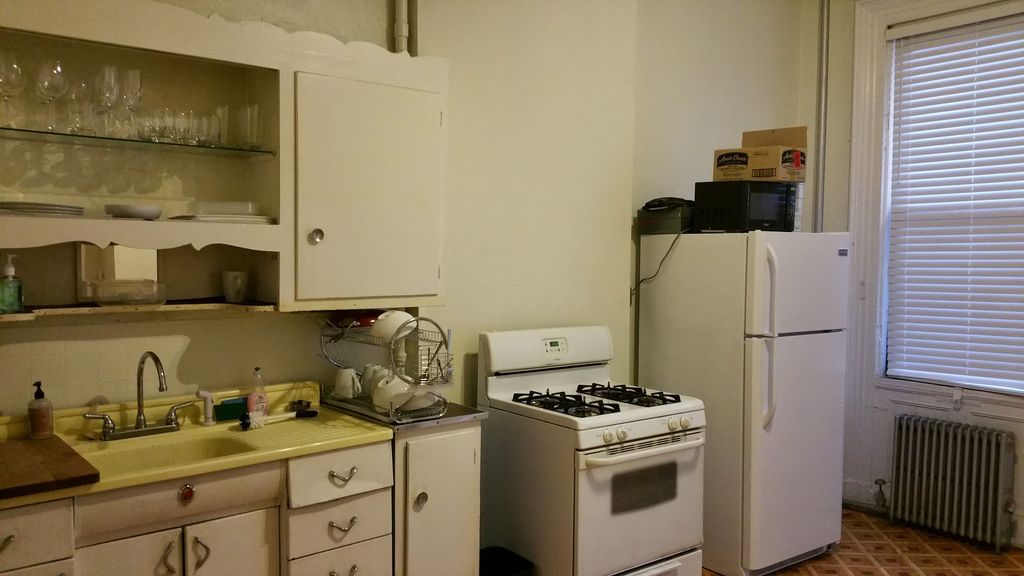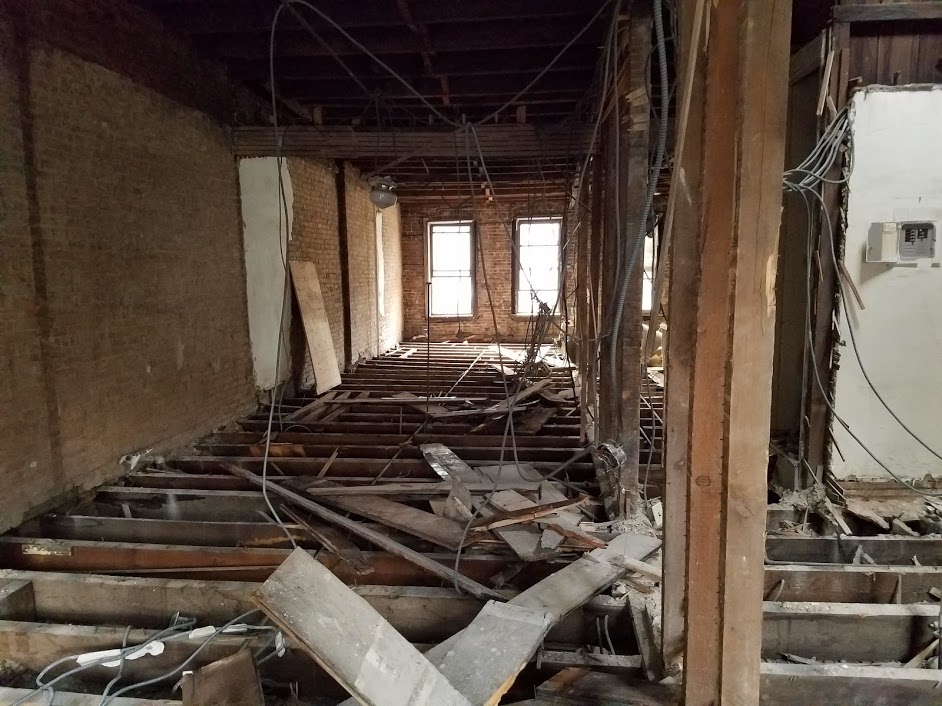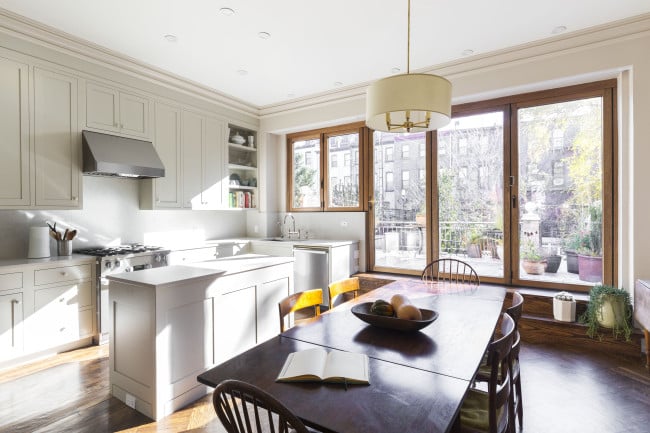What you should know before you renovate your NYC brownstone kitchen

This renovated brownstone kitchen now has brighter lighting, updated appliances and fixtures, a floating storage area, and a wall of black cabinets.
When you own a brownstone, there are no board-regulated restrictions on renovations like there are in condos or co-ops, but there are still plenty of challenges. Historic properties are sometimes landmarked, adding an extra layer of red tape. But even a non-landmarked brownstone presents obstacles common in homes that are more than a century old.
As the CEO and founder of Gallery Kitchen & Bath, a full-service design, selection, and build firm, I’ve overseen interior renovation of apartments, brownstones, and townhomes in Manhattan, Brooklyn, and parts of Queens for 5 years. I can tell you that inconsistent upkeep, outdated plumbing, and insulation issues are just a few examples of the challenges you’ll face as a brownstone owner.
It’s important to know exactly what to expect during a kitchen renovation, which is one of our top requests. Here are some of the issues that you are likely to face.

Historic infrastructure is likely outdated
The old infrastructure of a brownstone is one of the biggest concerns when it comes to renovating a kitchen. If the kitchen hasn’t been renovated in a while, you’ll likely find galvanized plumbing that has to be removed due to clogging and poor water flow. You might also find cloth wiring, which doesn’t comply with current fire safety code and poses a fire hazard and will need to be replaced. Plus, it’s possible that your home’s electrical system will require an upgrade to accommodate the appliances and electrical load typical in a modern kitchen.
Finally, you’ll want to install a flat, continuous floor, which is essential for ensuring your cabinetry and finished floor do not cause issues months after your project is complete. This can be tricky in a brownstone—you might need to reframe your walls and floors before you begin your project. For a typical brownstone kitchen, this can cost $4,000 to $8,000, depending on how much work is actually involved.
For example, if the project requires sistering, or shoring up the floor beams, it will likely reach the higher end of the range. If you want to save some money, tiling the kitchen floor, which doesn’t require sistering, will help.
You need an inspector who knows brownstones
The best way to ensure all these infrastructure issues are addressed safely and successfully during your brownstone kitchen renovation, especially if you are purchasing your home with the intent to remodel, is to hire an independent inspector who specializes in brownstones. He or she can advise you about each of these challenges and how best to overcome them so that you know what to expect once you bring in a contractor. A comprehensive inspection and the advice that comes with it does come with a price tag, sure—a good one will typically charge in the ballpark of $800 to $1,000—but it’s worth it to learn what you’re getting into before starting your project. Then, once it’s time to choose a contractor, pick someone with similar brownstone experience who can corroborate the advice your inspector gave you.

Do things by the book
Every successful kitchen renovation starts with smart planning, but it’s even more important when you have the flexibility to do whatever you wish. To help narrow down your choices, start with these questions: Do you want to relocate the kitchen? Expand it? Add a custom wall? What would you be sacrificing and gaining with these major footprint changes? Is your design aesthetic more classic, modern, or a mix of both? Should you hire an architect, designer, or a firm that handles it all for you?
The answers to these questions will tell you how much red tape you’ll have to cut through before starting your project. First, you’ll need a work permit from the Department of Buildings, depending on the price of your renovation. An architect is required to file plans with the department, but that does not mean you should start the process by hiring an architect first. If your brownstone is landmarked, you’ll also need to file for permits and adhere to requirements from the Landmarks Preservation Commission. LPC has a starting flat fee of $95 on the first $25,000 worth of work. From there, it’s $5 for each additional $1,000 of work.
If you’re considering a larger project that involves adding more square footage to your home and altering its facade, those permits will cost more. Want some help filing for all these permits? Choose a full-service contractor with architects on staff who will be able to take care of the application and approval process for you, saving you money and stress. While you need an architect to file plans necessary to procure your permits, different architects operate under different models. A design-driven architect who brings in another contractor will likely charge somewhere in the neighborhood of 10 percent of the total renovation cost as his or her fee. Usually these types of architects also have a minimum, so you can easily expect to spend $15,000 to $20,000. On the other hand, an architect who is tasked more simply with expediting and procuring permits might charge only $3,000 to $5,000.
Prepare for the costs
Brownstone renovations can easily reach into the six-figure range. It’s important to do your homework in order to ensure that you achieve your ideal outcome while avoiding wasteful spending. It’s equally important to choose a team that specializes in brownstones and their unique cost considerations.
Hiring the wrong experts is one of the most common areas of wasteful spending, especially on brownstones renovations. To avoid it, most brownstone owners benefit from hiring a reputable design and build firm that has the experience to know which professionals are best suited for each project. This is not to say that hiring an architect to oversee your renovation is a bad idea, but you should be prepared to spend significantly more by having an independent owners agent tasked with filing plans and overseeing the project, as discussed above.
A good alternative is a reputable, full-service design and build firm that has architects on staff or that works with architects who will file for your plans without charging the type of money an independent architect would. Some firms also have longstanding relationships with vendors that supply cabinetry, fixtures, and finishes to help you avoid paying the high retail prices you’d pay in-store. To be a smart consumer, it is wise to compare, but a reputable firm will pass along its trade discounts to you.
You might have expected that maintaining and improving your brownstone would come with special considerations, but that doesn’t mean renovating your home has to be overly complicated. If you keep these three things in mind, you can tackle your project with ease and create the kitchen you’ve always dreamed of.
You Might Also Like


























